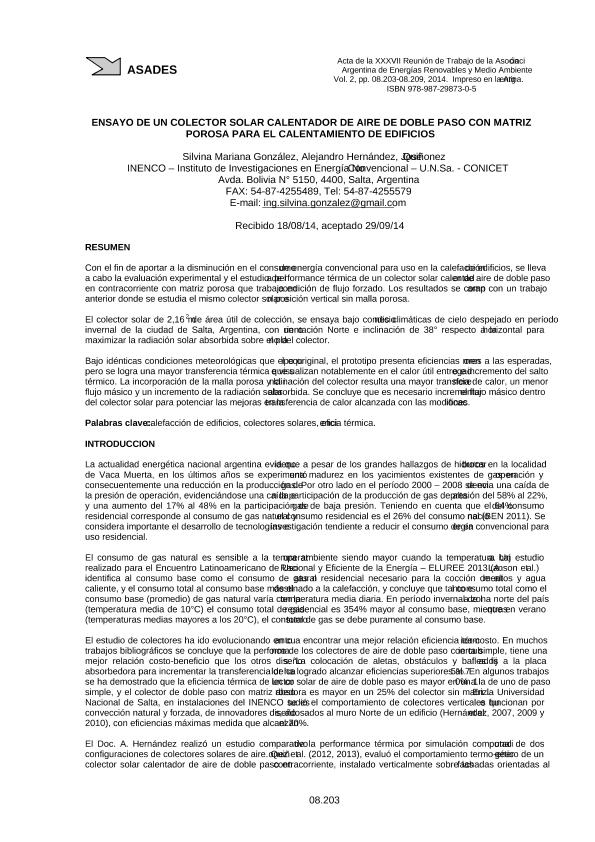Artículo
Con el fin de aportar a la disminución en el consumo de energía convencional para uso en la calefacción de edificios, se lleva a cabo la evaluación experimental y el estudio de la performance térmica de un colector solar calentador de aire de doble paso en contracorriente con matriz porosa que trabaja en condición de flujo forzado. Los resultados se comparan con un trabajo anterior donde se estudia el mismo colector solar en posición vertical sin malla porosa. El colector solar de 2,16 m2 de área útil de colección, se ensaya bajo condiciones climáticas de cielo despejado en período invernal de la ciudad de Salta, Argentina, con un orientación Norte e inclinación de 38° respecto a la horizontal para maximizar la radiación solar absorbida sobre el plano del colector. Bajo idénticas condiciones meteorológicas que el equipo original, el prototipo presenta eficiencias menores a las esperadas, pero se logra una mayor transferencia térmica que se visualizan notablemente en el calor útil entregado e incremento del salto térmico. La incorporación de la malla porosa y la inclinación del colector resulta una mayor transferencia de calor, un menor flujo másico y un incremento de la radiación solar absorbida. Se concluye que es necesario incrementar el flujo másico dentro del colector solar para potenciar las mejoras en la transferencia de calor alcanzada con las modificaciones. To contribute to the reduction in the consumption of conventional energy for use in heating buildings, it is performed the experimental evaluation and study of the thermal performance of a countercurrent double pass air solar collector with porous matrix which forced flow. The results are compared with a previous study in where you study the same solar collector, but upright without porous matrix. The solar collector with a useful collection´s area of 2,16 m2 , is tested under climatic conditions of clear sky in winter period of the city of Salta, Argentina, with a north orientation and inclination of 38 ° with respect to the horizontal to maximize solar radiation absorbed on the plane of the collector. The new design tested under the same weather conditions as the original collector, although it has lower efficiencies than expected, it has a higher heat transfer, which are displayed markedly in delivering useful heat and the large increase in the temperature difference between the inlet and outlet air temperatures. This is mainly due to the higher heat transfer between the absorber plate, the porous mesh and the circulating air, to the reduction of the mass flow and greater amount of solar radiation absorbed at changes collector's inclination. It is considered necessary to increase the mass flow into the solar collector, to enhance the improvement in heat transfer achieved with the addition of porous mesh.
Ensayo de un colector solar calentador de aire de doble paso con matriz porosa para el calentamiento de edificios
Fecha de publicación:
08/2014
Editorial:
Asociación Argentina de Energía Solar y Ambiente
Revista:
Avances en Energias Renovables y Medio Ambiente
ISSN:
2314-1433
Idioma:
Español
Tipo de recurso:
Artículo publicado
Clasificación temática:
Resumen
Palabras clave:
Calefaccion
,
Edificios
,
Colectores
,
Solares
,
Eficiencia
,
Termica
Archivos asociados
Licencia
Identificadores
Colecciones
Articulos(INENCO)
Articulos de INST.DE INVEST.EN ENERGIA NO CONVENCIONAL
Articulos de INST.DE INVEST.EN ENERGIA NO CONVENCIONAL
Citación
González, Silvina Mariana; Hernández, Alejandro Luis; Quiñonez, José Eduardo; Ensayo de un colector solar calentador de aire de doble paso con matriz porosa para el calentamiento de edificios ; Asociación Argentina de Energía Solar y Ambiente; Avances en Energias Renovables y Medio Ambiente; 18; 1; 8-2014; 89-95
Compartir




